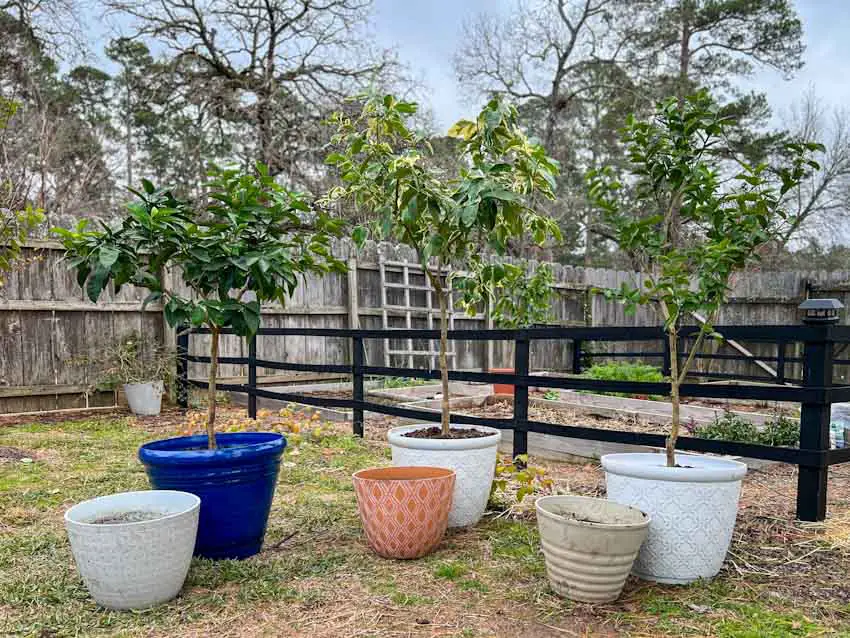
We may receive commissions from purchases made through links in this post, at no additional cost to you.
Have you noticed your container fruit trees looking a little lackluster lately? Or maybe they didn’t fruit as well this year. One of the most common reasons for under-performing potted fruit trees is that they’ve been sitting in the same pot (and the same potting soil) for far too long.
Container grown fruit trees will become stressed in depleted soil or a too-small pot. Growing fruit in containers is a great solution for small gardens or for fruit varieties that need winter protection. But it takes a little more than just plopping the tree in a pot with some soil and watching it grow.
Repotting with new soil and/or a bigger pot is the simplest thing you can do to keep your fruit trees thriving and producing tons of fruit. Below I’ve included info on every step of the process, from choosing the right pot size and soil to settling the tree into its new (or refreshed) home. But first, when is the best time to do this?
How to Know It’s Time to Repot
Potted fruit trees need just as much preparation, care, and maintenance as those grown in the ground (in some cases more!). As the tree grows, its roots need more room to spread out, even in the restricted environment of a pot. Also the potting soil becomes displaced by the root ball, depleted of nutrients, and loses the ability to retain moisture.
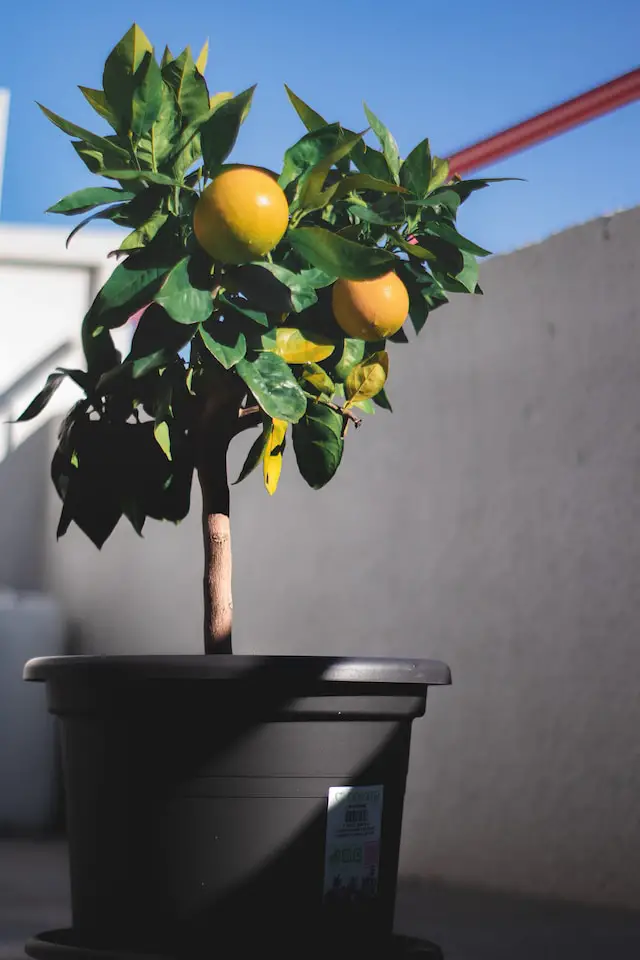
Because of this, container fruit trees should be repotted every 2-3 years. By “repotting,” I mean removing the tree from its container, and either putting it in a larger container or replacing it in the same pot but with new potting soil.
Even if you aren’t moving the tree to a bigger pot (if you kept doing this indefinitely your pot would be the size of a car!), fruit trees still need fresh potting mix every few years to keep growing and fruiting well.
Signs Your Tree Needs Repotting
If you skip this step of container fruit tree care, it won’t take long before the roots become potbound. A dense, matted rootball causes all sorts of problems. The roots spiral around and around in the pot until they basically choke themselves, leaving no room for further growth. This also means there is not enough room left for soil, which leads to a lack of moisture and nutrients.
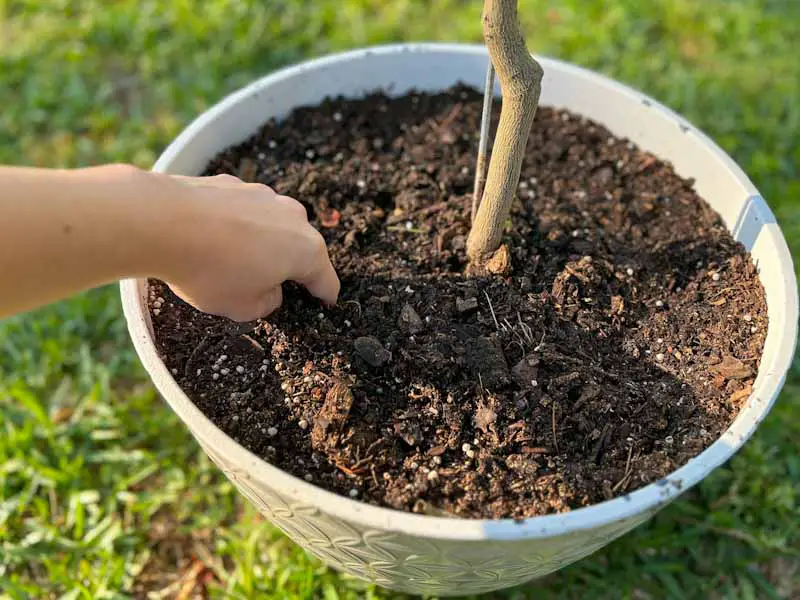
A tree that’s running out of room in the pot may have roots coming out of the bottom drainage holes or poking out of the top of the pot. Stick your finger in the pot – if you can’t push your finger into the soil because a mesh of roots is in the way, then it’s time to repot.
Another sign is what happens when you water the tree. Does the soil look compacted? Does the water tend to run down the side of the root ball rather than soaking into the soil? Does water drain out way too quickly? This probably means the root ball is taking up too much space and there isn’t enough soil left in the pot.
Related: Is Your Citrus Tree Overwatered or Underwatered?
A dead giveaway is the overall size of the tree. Does the canopy look too large in comparison to the size of the pot? I noticed this with one of my container citrus trees. The canopy was lush and green, but the tree was clearly top-heavy – it kept tipping over in strong winds.
Finally, pay attention to how the tree is growing. If the tree isn’t getting enough nutrients or moisture from the soil it will show up in the leaves. Typically, nutrient deficiencies show as abnormally pale or yellowing leaves. Moisture stress symptoms can include yellowed, brown, or curling leaves, or leaves falling off the tree.
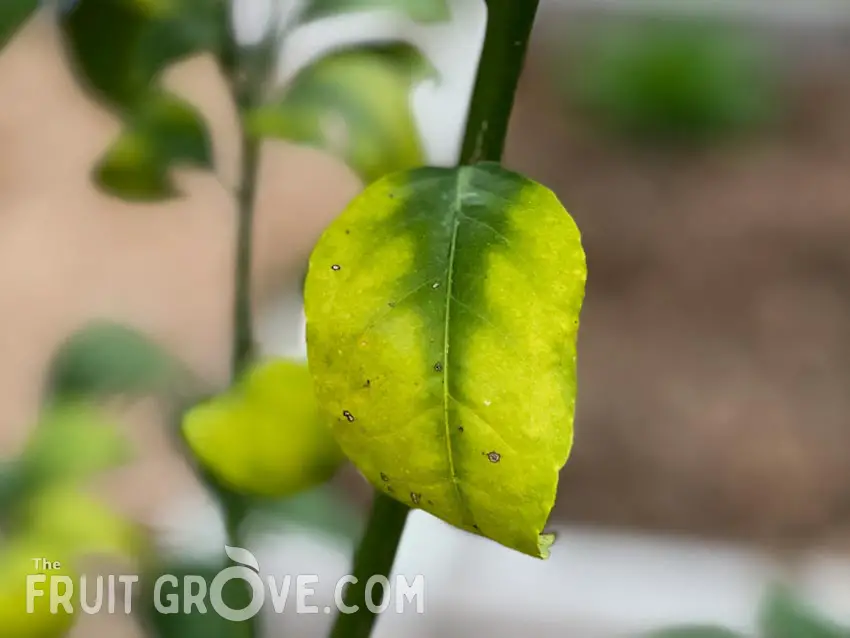
Related: Yellowing Lemon Tree Leaves? Here’s 5 Reasons Why
A pot-stressed tree will often have trouble fruiting. A smaller-than usual fruit crop could mean that it’s time to refresh the soil or pot up. You may also notice blossoms or young fruit that drop prematurely, due to the tree not having the energy to support fruit development.
Learn more: Lack of Lemons? Troubleshooting a Fruitless Lemon Tree
Choosing the Right Container
Should you keep potting up in size, or is it time to stick with the same pot? There are reasons for both options:
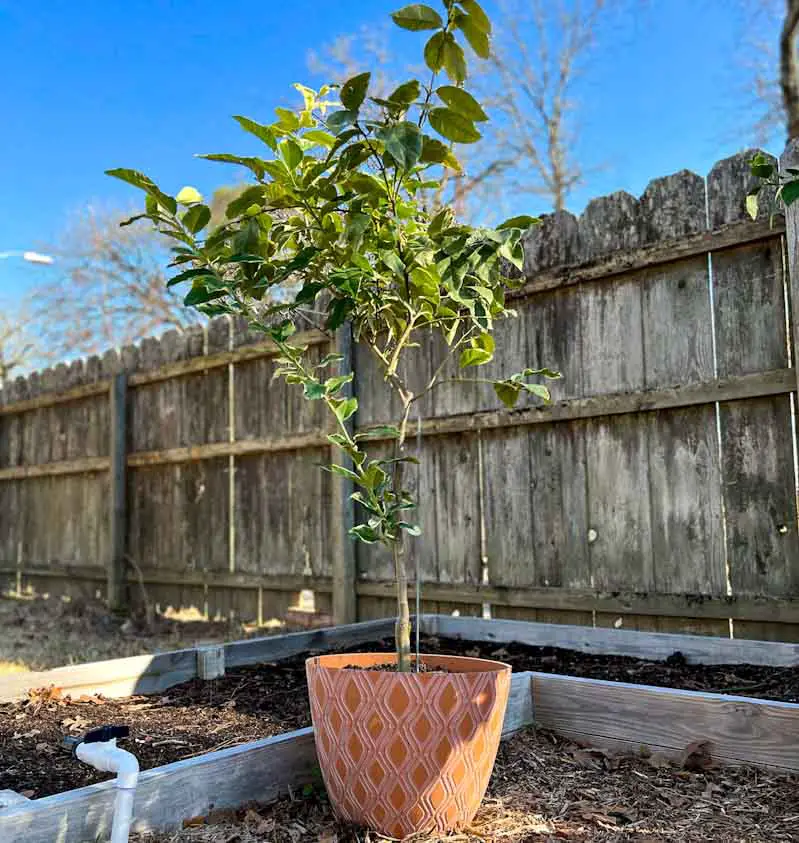
Use a new pot if…
- …you want to size up to a bigger container (see the next section). When the tree is young and growing very actively, keep moving it to a slightly bigger pot until the tree approaches its mature size.
- …you need to replace a damaged or cracked pot. It’s best to disturb the roots as little as possible, so if the pot needs replacing, go ahead and refresh the soil too.
- …you suspect the tree is root bound. If you’re worried about the size of the root ball, don’t wait. It may be time to move the tree to a larger pot so the roots have room to keep growing.
- …your old pot is ugly. We’ve all been there, right? After a while, that old black nursery pot just isn’t working anymore. Take this opportunity to choose something you like looking at!
Reuse the same pot if…
- …the tree is fully grown. Depending on the variety, this could take several years. If you notice the tree’s growth is slowing each season, or if you see that it’s approaching the mature size listed on the plant tag, it’s probably about as big as it’s going to get. There’s no reason to pot up to a bigger size.
- …you don’t have room for a larger pot. You may only have so much space. Or, perhaps you need to be able to move the tree into a garage or shed over the winter. You can absolutely limit the size of the tree by limiting the size of the pot. Just be prepared to do some root trimming (see below).
- …you just want to inspect the roots. If you think there may be some root rot, or if you think the tree is getting root bound, don’t wait. Repotting is a great excuse to check the health of the root system.
What size pot should I use?
If you’re potting up to a bigger container, choose one that’s only about 2-4 inches bigger in diameter. A move to a much bigger pot probably won’t hurt the tree, but it can cause some problems.
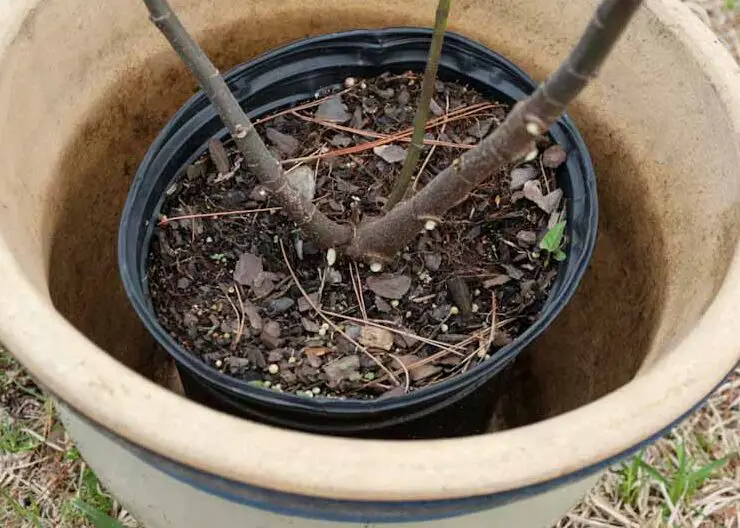
For one thing, the more soil there is in relation to the root ball, the more it will retain moisture. Adequate drainage holes will help prevent waterlogging, but it’s much easier to accidentally overwater the tree if it’s swimming in moist soil. Fruit trees hate “wet feet” and can develop fatal root rot very quickly.
Also, a tree planted in a too-large pot is likely to slow down its growth for a time. The tree will put more energy into growing a root system to fill the pot. Then it sends out more shoots and leaves (rather than fruit) to balance the root system.
Many fruit trees (such as figs, for example) love having slightly restricted roots. That little bit of stress sends the tree into reproduction mode – which means flowers and fruit! If you want the best fruit harvest possible from your potted tree, size up only a little at a time.
How to Repot Your Fruit Trees
Check out the video below to see how I repotted my three citrus trees (which they badly needed!):
1. Gather supplies.
- tarp or blanket
- new pot (if using)
- new potting mix (see below for details)
- trowel
- gloves
- sharp, sanitized pruning shears or soil knife (for root trimming, if necessary)
- mulch
2. Remove tree from container.
Carefully ease the tree out of its old pot and onto the tarp. Brush off any old soil from the root ball until the roots are bare. Inspect the roots for signs of root rot and trim away any damaged areas. If you plan to re-use the pot, give it a good scrub.
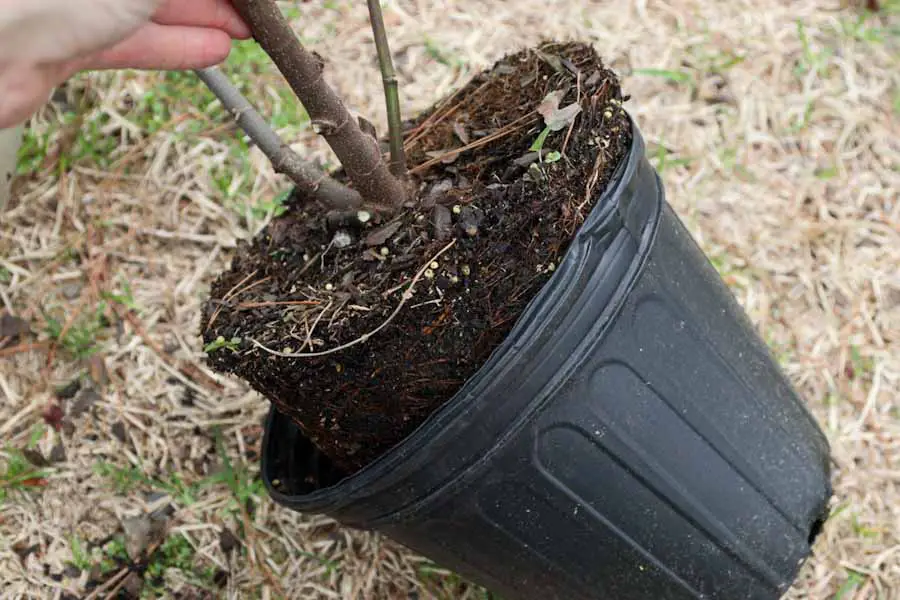
3. Trim roots if necessary.
If you are moving the tree to a bigger container, there’s no need to trim the roots unless they seem excessively potbound. If you plan to keep the same container, trim the root ball by about 1/4 to 1/3. Use sharp, sanitized pruning shears or a garden knife to cut back the base of the root ball.
4. Place the tree in its pot.
Fill the bottom of the container with a few inches of potting mix. Place the tree into the pot, double checking that the top of the root ball is about 2 inches below the rim of the pot (you don’t want to plant too deep!), and add more soil to the bottom if necessary. Backfill around the tree with more potting mix, tamping down firmly as you go. Keep the top of the root ball right at (or just barely under) the surface of the soil.
5. Water and mulch.
Water the pot thoroughly until you see water draining out of the bottom. Add a couple of inches of mulch (such as pine bark) to the top of the pot to help retain moisture.
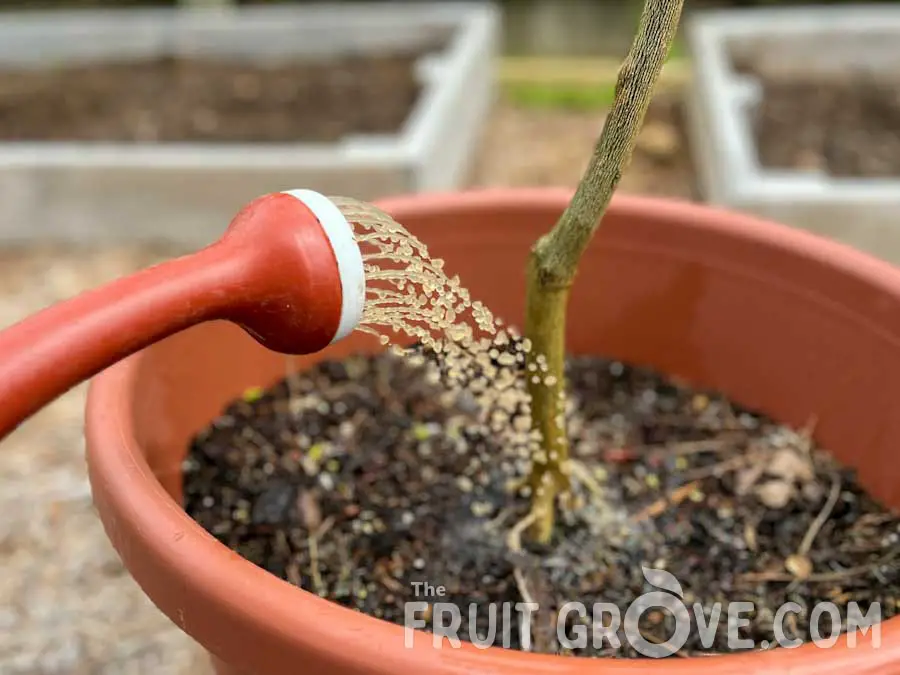
Do you need to fertilize?
I don’t recommend fertilizing when you repot. The fresh potting mix will do the job of providing some nutrition to the roots for a little while. Transplanting is stressful, so you don’t want to run the risk of stressing the plant further by fertilizing right away. Give the tree a chance to settle into its new container home before giving it a boost of nutrients.
If anything, mix in a little slow-release organic granular fertilizer (such as Dr. Earth Organic Fruit Tree Fertilizer) with the potting mix before you repot. This will break down more slowly and become available to the roots when they need it. I suggest avoiding commercial potting mixes that have chemical fertilizers already in them, because these can burn the sensitive transplanted roots.
A Quick Note About Fruit Tree Potting Mix
Choose a potting mix that is very well draining and contains a balance of large particles (such as pine bark) and water retaining ingredients (such as coconut coir or compost).
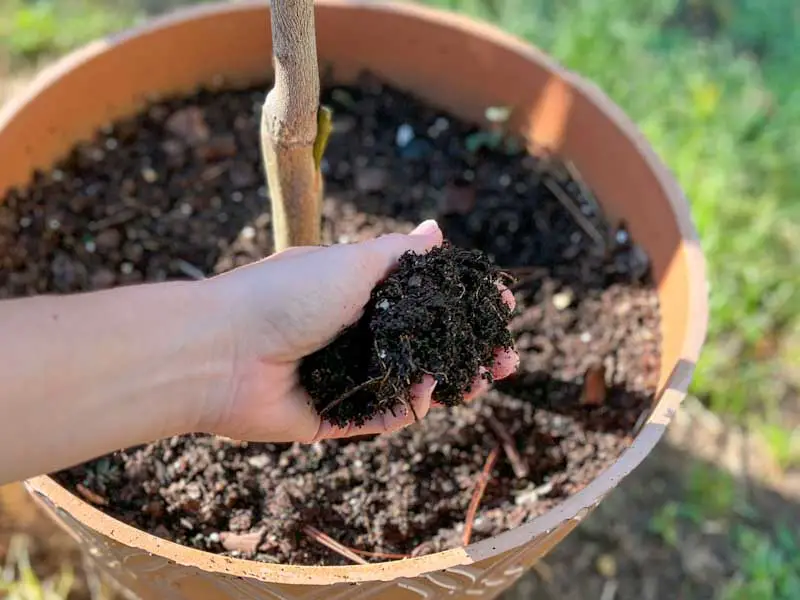
I often make my own fruit tree potting mix with the following approximate ratios: 4 parts pine bark (preferably partially composted pine fines), 1 part coconut coir (or peat moss), 1 part coarse perlite, 1 part good-quality compost (or a mixture of compost, manure, worm castings).
My other favorite option is to buy a good quality potting mix (options below) and then add pine bark and/or perlite to it to improve the drainage. Commercial potting mixes almost always are made of very fine particles, which become easily compacted in a large pot.
Fruit Tree Potting Mix Recommendations:
Fox Farm Ocean Forest Potting Soil
This is a premium potting mix that is optimized for healthy plant growth. I like that it contains earthworm castings, bat guano, forest humus, fish meal, and other nutrient-rich ingredients. It is a very fine mix, so definitely plan to add 25-30% pine bark and some perlite to help water drain through, otherwise it will become compacted in the pot.
Miracle-Gro Performance Organics Raised Bed Mix
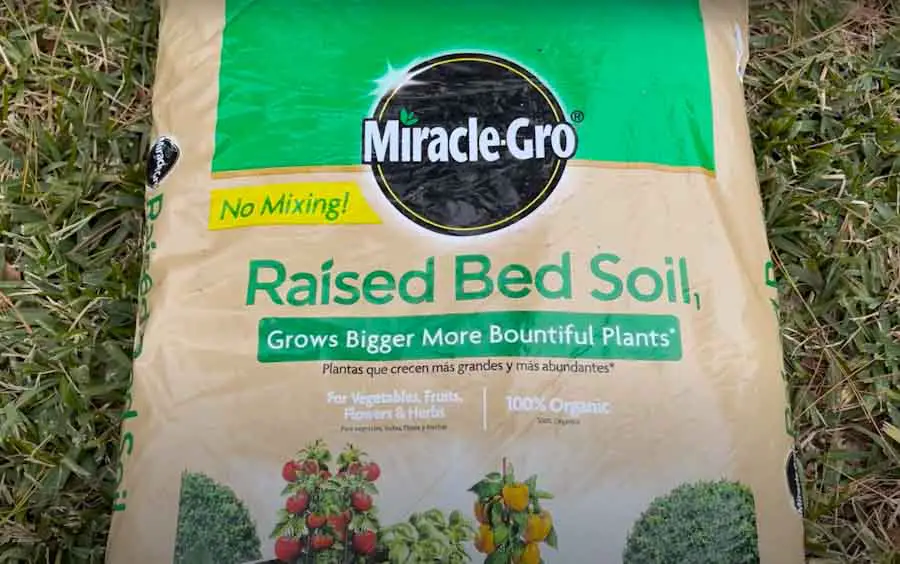
I recently discovered this product, and it’s a good affordable option for potted fruit trees. It contains peat moss, compost, and coir, among other things. It has less of the premium ingredients and more of nutrient-light “forest products” (which means aged pine bark and wood shavings mostly) to provide structure to the soil. This isn’t necessarily a bad thing since you need the mix to drain well.
I combined this with the Ocean Forest and some pine bark when I repotted my citrus trees (see the video above) and was really happy with the results.
Back to the Roots Organic Potting Mix
This is a nutrient-rich peat-free potting mix. I haven’t tried it yet, but it has a great list of ingredients including coconut coir, myccorhizae (to stimulate root growth), and lime to balance pH. If you’re avoiding peat moss in your garden because of sustainability issues, this is a good option.

